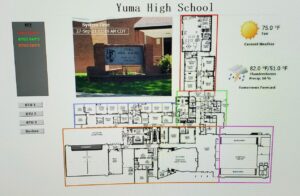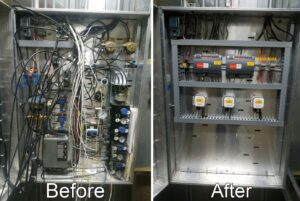A Building Automation System (BAS) acts as the brain of your facility. It is the motherboard that integrates and controls heating, ventilation, air conditioning, lighting, security, and other systems. To do this, they utilize a combination of sensors, controllers, and software to monitor these systems. A central location receives this information, allowing the user to view all systems from a single control panel. This increases visibility into equipment operation and can help to improve efficiency.
A properly commissioned BAS plays a critical role in improving operational efficiency, maintenance practices, and decision-making in facility management.
Real-Time Monitoring, Data Collection, and System Alarms


Picture of a BAS System we installed that is monitoring 3 RTU’s and a Boiler System.
Real-time monitoring and data collection provides a clear picture of how your equipment is working and allows you to make adjustments with immediate feedback. It also enables facility managers to oversee building operations, detect anomalies, and respond promptly to potential issues.
Data collection involves the continuous gathering of information from various sensors, meters, and devices installed throughout a building. Historical data, typically referred to as trends, can be analyzed to uncover valuable insights into building performance, energy usage, and operational efficacy. This trended data empowers facility managers to make informed decisions and drive continuous improvement in building management.
Alarms in Building Automation Systems provide immediate alerts and response capabilities to potential issues or emergencies within a facility. By detecting abnormal conditions, they can notify relevant personnel, and facilitating rapid response efforts. Alarm services contribute to the safety, security, and efficiency of buildings, ensuring the well-being of occupants and the protection of assets.
Increased Efficiency, Decreased Expenses
Enhanced operational efficiency is one of the primary benefits of implementing a BAS. A well-tuned system optimizes mechanical system performance and allows facility managers to visualize equipment data and performance. This results in better data-driven decisions.
Remotely monitoring means even when not on-site, facility managers can stay up to date on their buildings’ most important systems. BAS also increases occupant comfort, which leads to more work getting done during business hours, and it provides for more effective energy management.
5 Ways They Saves Money
A few ways Building Automation Systems can contribute to cost savings are:
- BAS can automatically adjust HVAC systems based on occupancy, temperature, and time of day to reduce energy consumption.
- They can also automatically shut off lights when a room is not in use to reduce energy waste.
- BAS can utilize sensors and analytics to predict when equipment is likely to fail or require maintenance. By addressing issues proactively, businesses can avoid costly emergency repairs and extend the life of equipment.
- Control strategies such as Optimal Start, Trim and Respond, Demand Ventilation, and others can radically reduce energy usage without adversely affecting occupant comfort.
- In addition, a BAS can aid in compliance with regulatory requirements, preventing otherwise unanticipated administrative expenses.
Case Studies and Statistics


Replacing old pneumatic air handler controls with Honeywell BAS Controls.
“Nearly 60% of commercial buildings over 50,000 square feet in the United States have a building automation system…. But only 13% of small- to medium-size (<50,000 square feet) buildings have adopted the technology. Leaving over 75% of all commercial buildings in the U.S. primed for opportunity.”
Fortune Business Insights has estimated that the BAS worldwide market size was at $77.09 billion in 2023. And according to Forbes, it is only going to continue to grow. Forbes has forecast a compound annual growth rate of 21.6% over the next five years. They anticipate the market value of BAS to be over $200 billion in 2028.
If that isn’t enough of a reason to start looking seriously at BAS consider this study by The US Department of Energy. Energy savings averaged 29% across all commercial buildings, with secondary schools and standalone retail stores seeing savings of over 40%. The greatest savings are shown to come from controlling HVAC equipment. By adjusting setpoints (reduction of ~8%), reducing minimum air flow (~7%), and utilizing occupancy control (~6%).
Emerging Tech Trends in Building Automation
Building Automation Systems now integrate with a wide range of Internet of Things (IOT) devices, including sensors, actuators, smart thermostats, and lighting controls. This allows for more granular control and improvement of system performance. We anticipate this integration continuing to get better with time. Using cloud-based BAS platforms, facility managers can monitor and control building systems from anywhere.
Using data analytics and machine learning algorithms, a BAS can examine large datasets collected from building sensors and devices. This enables predictive maintenance, anomaly detection, and optimization of energy usage based on historical patterns and concurrent data. Furthermore, Edge computing technology allows for data processing and analysis to occur closer to the source, reducing latency and improving responsiveness in BAS applications.
Modern Building Automation Systems feature intuitive user interfaces with interactive dashboards and visualization tools. This provides facility managers with actionable insights and real-time performance metrics. Advanced security measures such as encryption, authentication, and intrusion detection help protect against cyber threats and ensure the integrity of building systems.
Installing A Building Automation System
Installing a BAS is a process that demands careful planning and expertise. The initial installation involves an assessment of the HVAC, lighting, security, and other systems. Next, technicians strategically place sensors, controllers, and other BMS components on equipment to ensure optimal functionality. During the installation, integration with existing infrastructure and thorough testing are critical.
The University of Michigan’s Maintenance Service Department did a good job of laying out the key steps. When they install a Building Automation System on campus, they do all of the following steps:
(Important Note: They have at least 3 individuals on staff dedicated to just BAS)
- Calculate and compile data for DDC points
- Install the database into the central system from a designated work terminal
- Develop program lines in accordance with the engineered “sequence of operation”
- Terminate pneumatic tubing and electrical wiring
- Set up raceways for pneumatic tubing
- Set up raceways for electrical and electronic wiring
- Install field input devices: temperature, humidity, CO2, air flow, and water flow sensors
- Install field output devices: electric to pneumatic transducers, analog to voltage transducers, analog to current transducers, valve and damper actuators
- Initiate system startup and conduct field tests
- Make necessary adjustments to fine-tune system operation
Maintaining A BAS System
Regular maintenance of the system is equally crucial to sustain long-term efficiency. This involves routine inspections, software updates, and calibration checks to identify and address any potential issues.
Just like most technology, things can change fast! This makes continuous staff training on Building Automation Systems usage, troubleshooting and updates essential. Additionally, collaborating with experienced professionals will help ensure that your team and the BMS stay up to date with changes in the technology.
Take Your Facility to the Next Level with an RMS Building Automation System
Implementing a Building Automation System empowers facility managers to drive significant energy savings, streamline operations, and enhance occupant comfort. All of which ultimately leads to better building performance and reduced costs. Embracing BAS technology positions facility managers as stewards of sustainability and efficiency. It also ensures their facilities remain competitive and future-ready in an increasingly demanding market landscape.
Take control of your facility’s performance by exploring Building Automation System options with Rasmussen Mechanical Services today. Our Temperature Controls division is a Honeywell Authorized Controls Integrator (ACI), and we can help design the entire system from the ground up. Don’t miss out on the opportunity to drive cost savings, improve functionality, and stay ahead of the curve in facility management. If your current Building Automation System is outdated, ineffective, or simply non-existent, our team is ready to help. Call us at 1-800-237-3141, email sales@rasmech.com or contact us online.


